Delay is one of a handful of what are considered “core effects,” but what separates the cream of the crop from the rest, and why is it that you’ll find one of these units on eight out of every ten pedal boards?
This is because delay pedals add a distinctive depth to your sound, and different types of delay add different types of depth.
You can also stack delays to turn a few simple guitar chords into rich soundscapes.
In this KillerGuitarRigs Review, we’ll throw you a few recommendations straight away, then run you through what to look for when picking right delay for you, before counting down our favorite delays on the market today.
Read more about our review process.
Want to learn more about guitar pedals?
Check out our ultimate guide to guitar pedals to find more jumping off points.
Contents
- Our Top 2
- How to Choose The Right Delay For You
- Individual Reviews
- How to Choose the Right Delay
- Final Thoughts
Our Top 2
Our Best Budget pick (bearing in mind that delays are expensive pedals) is the TC Electronic Flashback 2. This regular-sized wonder has a big feature set, boasting eight different delay effects and four “toneprint” slots, whereby you can download a variety of tweaked delays and use them in your unit.
If money is no object, the undisputed best of the best, and our Editor’s Choice, is the Strymon Timeline. This is the king of pro pedal boards, boasting 12 different delay types, a 30-second stereo looper, and can hold up to 200 rewritable presets. Money can buy no better delay.
How to Choose The Right Delay For You
The first consideration with a delay pedal is whether you want to go for an analog or digital delay. Typically digital delays will be cleaner and give you more out-there effects, whereas analog will be richer and darker.
The second is how much delay you need. If you’re trying to spice up some solos with a little delay, you do not need the huge array of options in a Strymon Timeline. If you want to make vast audio soundscapes, an Echobrain is going to be too limiting.
Finally, the third consideration is power draw. Some of these delay pedals draw a ton of power, and you may find you’ll need to upgrade your pedal board power supply to accommodate.
We’ll go into further detail in our buyer’s guide, but first – let’s take a look at some pedals.
Individual Reviews
Strymon TimeLine
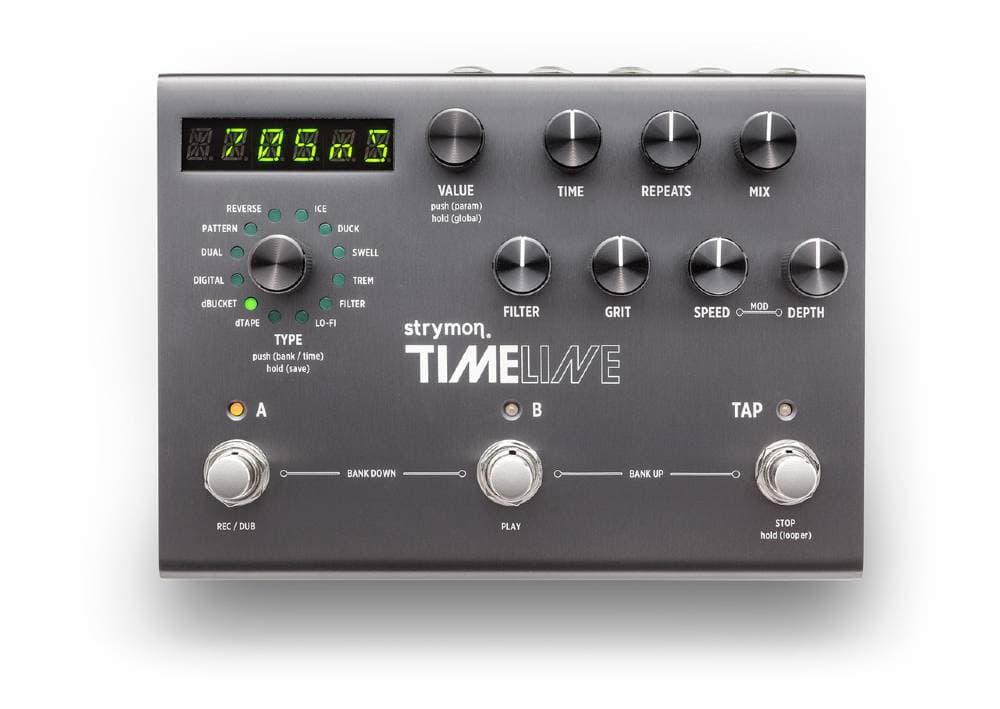
The big daddy of floor delay units
TimeLine Specs
- Pedal Type: Stereo multi-mode delay unit
- Bypass: True Bypass
- Controls: Value / Time / Repeats / Mix / Filter / Grit / Speed / Depth / Bank Selector A&B / Tap Tempo / Delay Type
- Sockets: Stereo in/out, MIDI in/out Expression pedal
- Power: 300mA
TimeLine Review
Strymon have a reputation for crafting some of the best pedals you can get, and the Timeline is arguably the pick of their US-made range.
With the Timeline, you get studio quality delays in a floor pedal.
The killer thing about the Timeline is you’re not just getting a pedal that does a few things well – the Timeline does a high-quality job at traditional delay types, as well as introducing a range of less conventional delays that bring a whole new sonic palette to delays.
For example, dual delay allows you to mix together a second set of repeats, giving your delay sound a spacious, almost reverb like sound (what you might consider a wash).
Filter delays allow you to add oscillation or resonance adjustments to the delayed signal, allowing you to stretch your guitar into synth-like sounds.
However, even the traditional delays have unique functions that elevate the Timeline above the pack. For example, on the dTape mode, which seeks to emulate tape delay, you can use the speed control to emulate tape crinkle of different amounts – essentially making the “tape” less or more destroyed.
From a practical standpoint, you can store up to 200 preset delays on the unit and access them using the three footswitches, which also control the on-board 30-second looper.
The seven knobs allow you to tweak your delays in obvious ways (time, repeats, mix) and more out there ways (grit, filter, modulation depth, depth) – and depending on the delay chosen, these knobs can perform different delay-specific functions.
Honestly, we could spend this entire review going through the feature set of just the Timeline and still only scratch the surface.
The only knock against the Strymon Timeline is the top-of-the-range price, but if you only ever want one delay, this is your guy – with no hesitation, we name this our favorite delay.
Boss DD-500
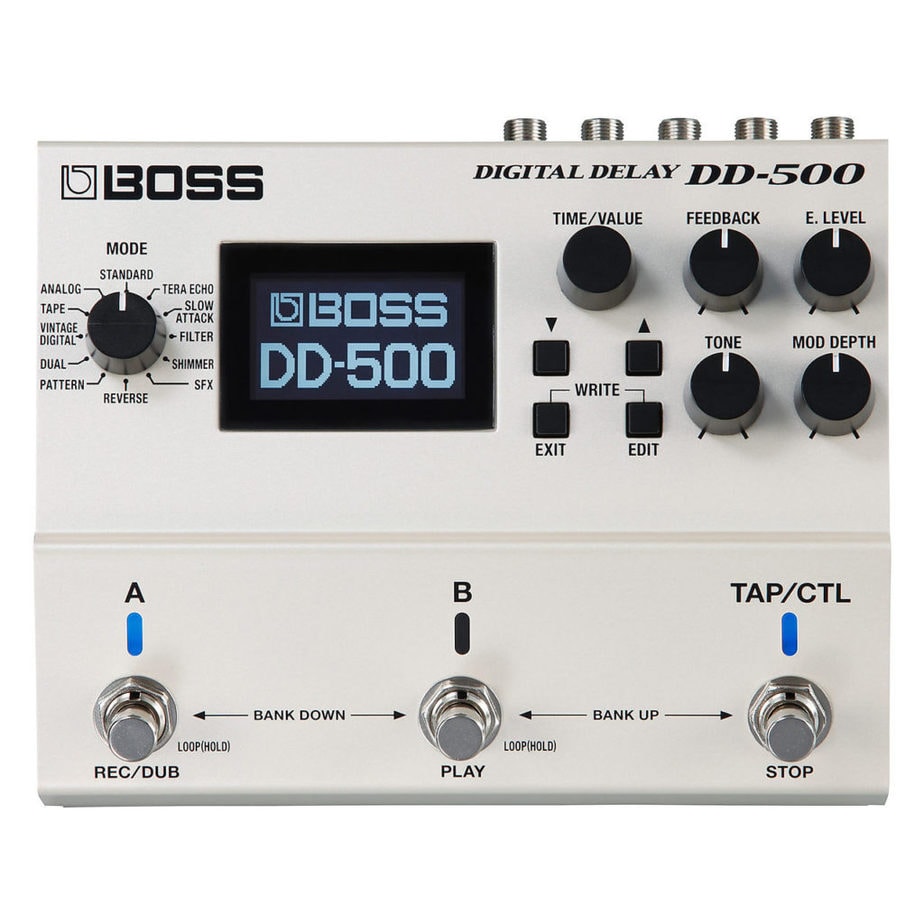
High end unit from pedal giant Boss
DD-500 Specs
- Pedal Type: Stereo multi-mode delay unit
- Bypass: Buffered bypass or True Bypass
- Controls: Time/Value / Feedback / E. Level / Tone / Mod Depth / Bank Selector A&B / Tap Control
- Sockets: Stereo in/out, MIDI in/out Expression pedal, USB
- Power: 9V, 200mA
DD-500 Review
Coming a close second to the Strymon Timeline, the DD500 is a powerful delay unit from the maker of some of the most popular pedals in history.
The Boss DD 500 allows you to save a massive 297 patches, and with the granularity of control you have over the delays in this unit, you might just use them all.
Where the Strymon Timeline comes out on top for the quality of the delays available, the DD-500 has incredible flexibility on it’s side, as well as being about $200 cheaper.
For example, the DD500 offers functions such as modulation on top of delays, giving it’s Tera Echo a touch of both chorus and vibrato. These extra textures allow tone searchers to go down the rabbit hole of getting the exact sound they want in a way the Timeline can’t.
It also leaves the Timeline’s looper in the dust, with an incredible 120 second looper on board.
In addition, for live use, it’s large bright screen is more practical for those trying to switch delays on a dark busy stage, plus it can run on power or from a 9v battery, while the Timeline needs a dedicated external power supply.
By the way – someone made a Eurorack module of a DD-500 – how cool is this?
Ultimately the choice between the two (other than price) comes down to this – do you want amazing delays out of the box, or do you want to get your hands dirty crafting the exact delays you want? Choice is yours!
TC Electronic Flashback 2
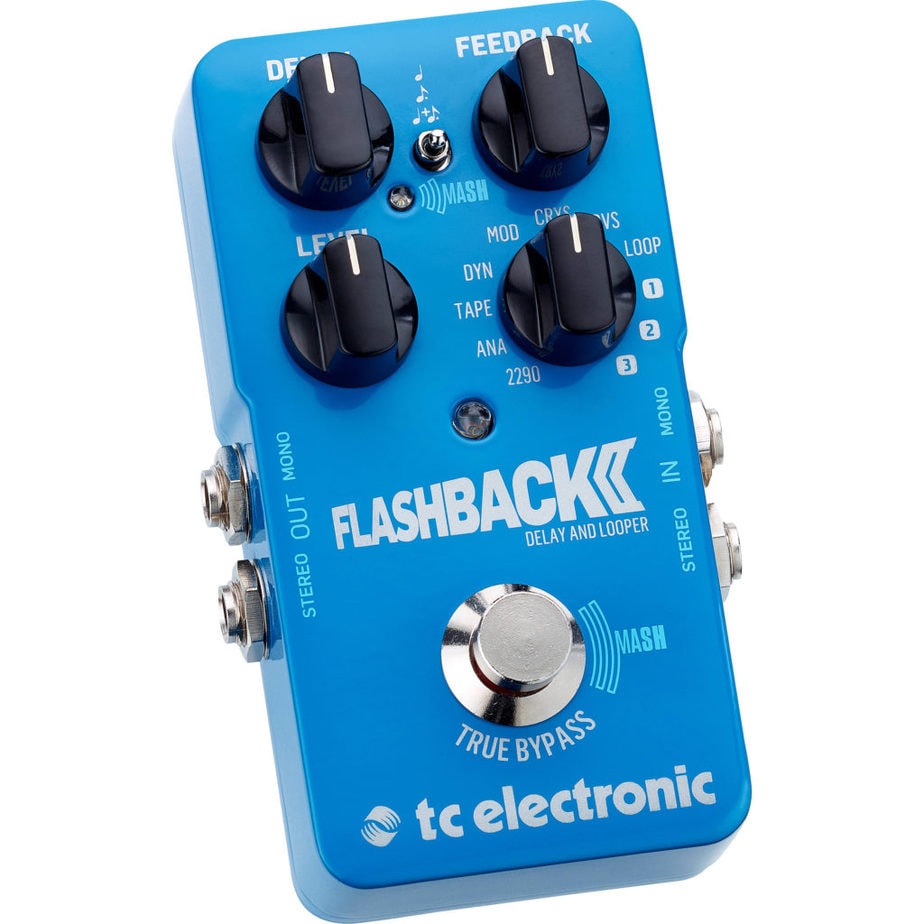
Versatile delay in a small, affordable package
Flashback 2 Specs
- Pedal Type: Compact Stereo multi-mode delay unit
- Bypass: Buffered bypass or True Bypass
- Controls: Delay / Feedback / Level / Mode / Subdivision
- Sockets: Stereo in/out, USB
- Power: 9V, 100mA
Flashback 2 Review
The original Flashback was widely popular due to its user-friendly design and quality delays, all in a compact and affordable package.
The Flashback 2 builds on this adding the Mash function, which basically means the foot switch is pressure sensitive, and this allows you to use it as an expression pedal of sorts, assigning different functions to different sensitivities.
However, if you use an expression pedal extensively, be warned that the technology isn’t at 100% and is more for limited use.
That being said, the Flashback provides a wide variety of high quality sounds that can be controlled directly on the unit, or loaded in via USB using the same toneprint technology TC Electronic use on their Hall Of Fame reverb pedal.
If you only want a handful of the Flashback’s tones, you can also get the Flashback Mini which allows you to load a smaller range of tones into the pedal and then make minor tweaks on the fly.
Overall, if you’re going small form factor and saving money over the big dogs – or you want a pedal you don’t have to worry about in a bar setting – the TC Electronic Flashback 2 is easily the delay for you.
Electro Harmonix Canyon Delay & Looper
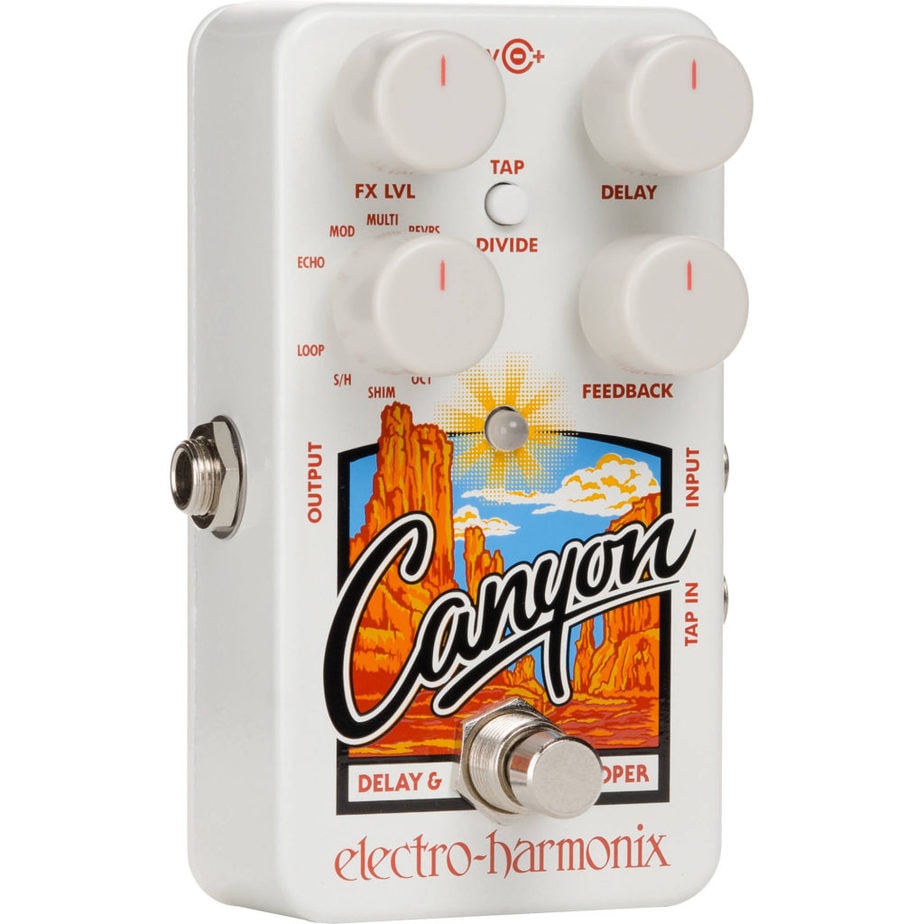
Two killer Electro Harmonix effects, one killer price
Canyon Specs
- Pedal Type: Compact Digital Delay & Looper Pedal
- Bypass: Buffered Bypass
- Controls: Level / Delay / Modes / Feedback / Tap Tempo
- Sockets: Mono In/out / Tap Tempo in
- Power: 150mA @ 9VDC
Canyon Review
Electro Harmonix are well known for making some of the best pedals on the market, from the classic Memory Man on down.
However, with their latest iteration, Electro Harmonix have taken the Deluxe Memory Man and created a more compact but still feature-packed iteration. Not only does the Canyon give you echoes that range from the familiar to the ethereal, but you also get a killer looper into the bargain.
One of the tricks up Electro Harmonix sleeve has to be the economy of the layout – with only a handful of knobs, you have access to a wide range of the best sounds you could expect at this price point.
They’ve even thrown in a DMM setting, giving you access to the classic Electro Harmonic Deluxe Memory Man sound – just in case you forgot why you were interested in Electro Harmonix digital delay pedals in the first place.
Overall, the comparatively new Canyon earns Electro Harmonix a place on any list of desirable delays, and maybe allows you to free up some space by taking your looper pedal off your board!
Source Audio Nemesis
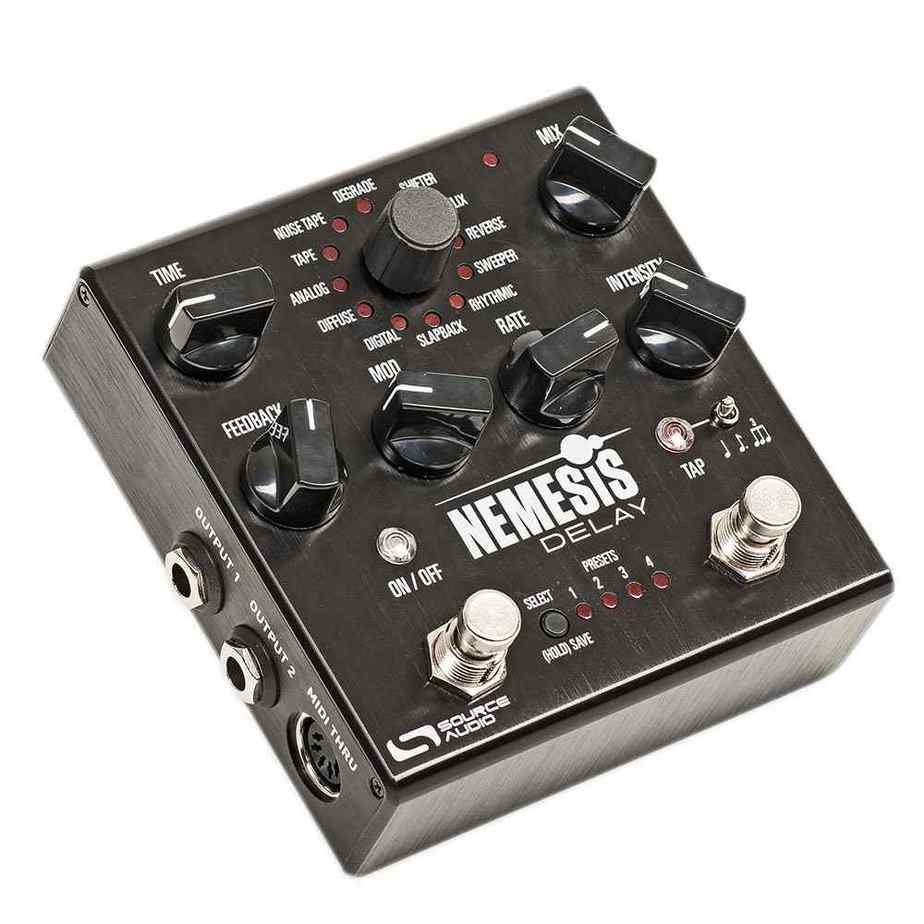
Multi-mode digital delay at an affordable price
Nemesis Specs
- Pedal Type: Stereo multi-mode digital delay unit
- Bypass: Buffered bypass or True Bypass
- Controls: Time / Feedback / Delay Type / Mod / Rate / Mix / Intensity / Tap
- Sockets: Stereo in/out, Expression pedal, Midi In, Midi Through, USB, Control input
- Power: 9V, 300mA
Nemesis Review
The Nemesis from Source Audio fills a particular niche in the market by catering more toward producer guitarists than pure players. The functionality that it comes with is second to none, making it one of the best pedals for that market, but those looking for something simple may find themselves overwhelmed.
It has 12 individual delay modes, as you would expect of a device of this type, and has tap tempo functionality. Further, it has MIDI and stereo I/O connectivity, which, when combined with the Source’s Neuro app, gives you a ludicrous amount of options to play around with.
An educated artist is going to be able to draft up some special stuff with the Nemesis, especially considering it retails under $300, but those without the production knowhow to make use of its many options may want to steer clear.
Boss DM-2W

Classic Boss compact delay with a Waza Craft update
DM-2W Specs
- Pedal Type: Compact analogue delay pedal
- Bypass: Buffered bypass
- Controls: Repeat Rate / Intensity / Echo / Standard or Custom switch
- Sockets: Input/Output, Rate, Direct Out
- Power: 9V, 35ma
DM-2W Review
Yet another Boss device, but this time it’s an analog. Similarly to the DD-3T, the DM-2W is a modern spin on a classic pedal that was discontinued back in the 80s but remains one of the most beloved delays of all time.
As with most Boss updates, this model retains its original sound impressively well while bringing some extra modern functionality to the mix. Mainly, the longer delay time thanks to a new custom mode, pushing out the delay to 800ms. You can also control the rate via expression input, giving you even more options to play around with, all while maintaining a classic analog tone and sound.
JOYO D-Seed
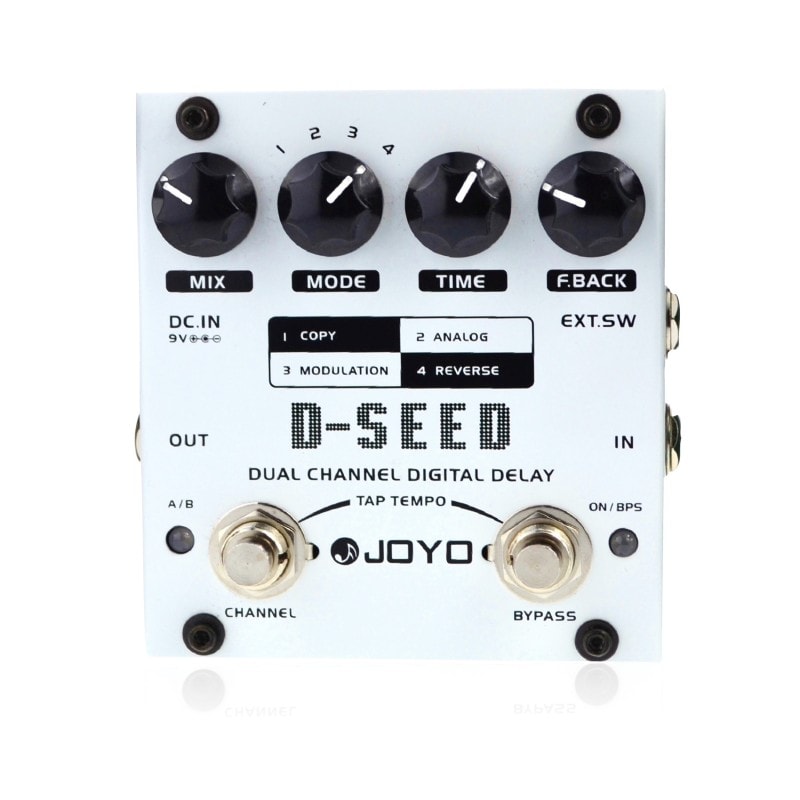
Four Digital Delays in a Joyo priced package
D-Seed Specs
- Pedal Type: Multi-Mode Digital delay unit
- Bypass: True Bypass
- Controls: Mix / Mode / Time / F.Back
- Sockets: Mono in/out, External Interface
- Power: 9V, 75ma
D-Seed Review
The JOYO D-Seed is an incredibly versatile digital delay, owing to its dual-channel design.
Each channel can save its own delay mode and delay time, as well as any other parameters or effects you want to throw in there. The two can be switched between one another with the built-in A/B switch, or you can use an external SW input.
The D-Seed has buffered bypass and does include tap tempo functionality on top of its four digital delay effects.
Its digital copy keeps your guitar’s original sound without any effects, fade, or distortion, giving you a clear and simple repeat. The analog mode also maintains that natural tone but features a smooth fade-out. Modulation gives a sense of space by modulating the repeat, which can be used to great effect by those who know what they’re doing. Lastly, reverse turns the delayed phase backward, giving your music a particularly psychedelic and interesting sound.
While four delay modes is on the lower side of things these days, the option of switching between two channels on the fly opens up the door to possibilities that would otherwise require you to have a more professional and expensive setup, making it one of the best under $100.
MXR Carbon Copy
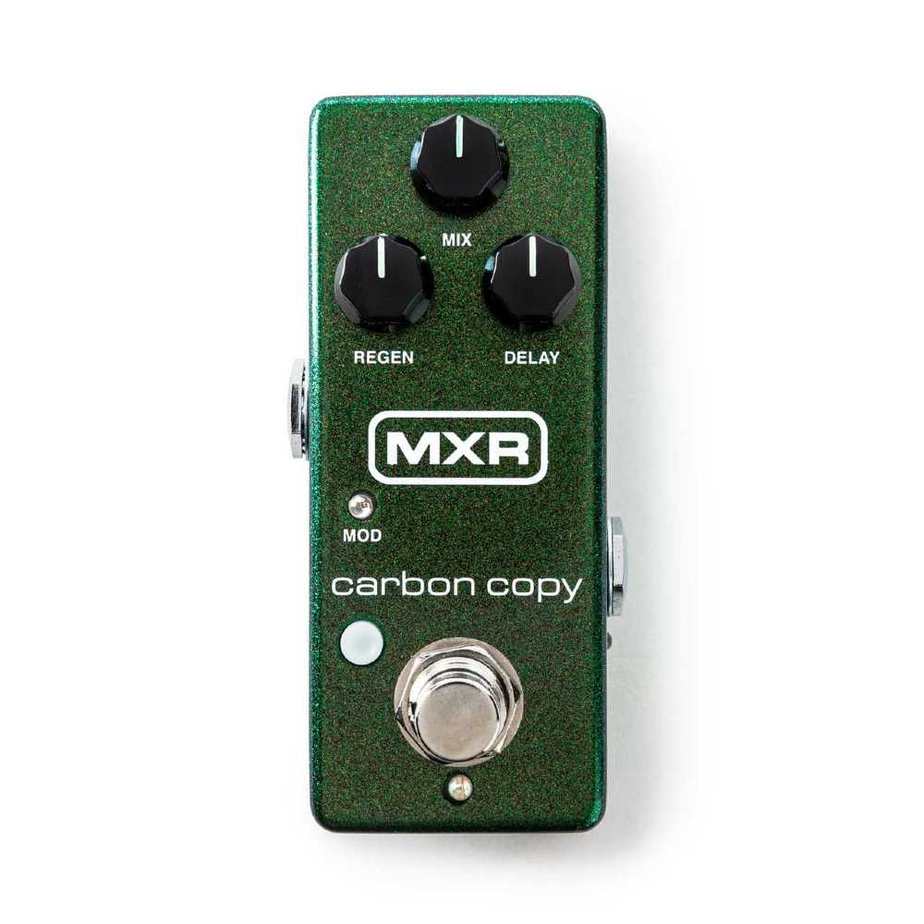
The perfect delay for those with simple needs
Carbon Copy Specs
- Pedal Type: Compact analog delay pedal
- Bypass: True Bypass
- Controls: Mix / Regen / Delay / Mod
- Sockets: Mono in/out
- Power: 9V, 26ma
Carbon Copy Review
The MXR Carbon Copy stands out from typical analog delay pedals due to the fact that it comes with modulation built into it.
As with all modulation effects, this gives the Carbon Copy a unique and distinctive sound that is unlike most other delay pedals on the market, especially when you consider that it is analog and not a digital delay.
While we’re not judging the pedals on this list based on their stackability, this MXR does stack particularly well when used correctly.
The MXR Carbon Copy Analog Delay isn’t going to be for everyone, and mainstream artists should give this one a miss, but for the eccentric soulful few that play in genres known for heavy, melodic modulation, this is a great budget option retailing for around $140.
Strymon El Capistan dTape Echo Delay
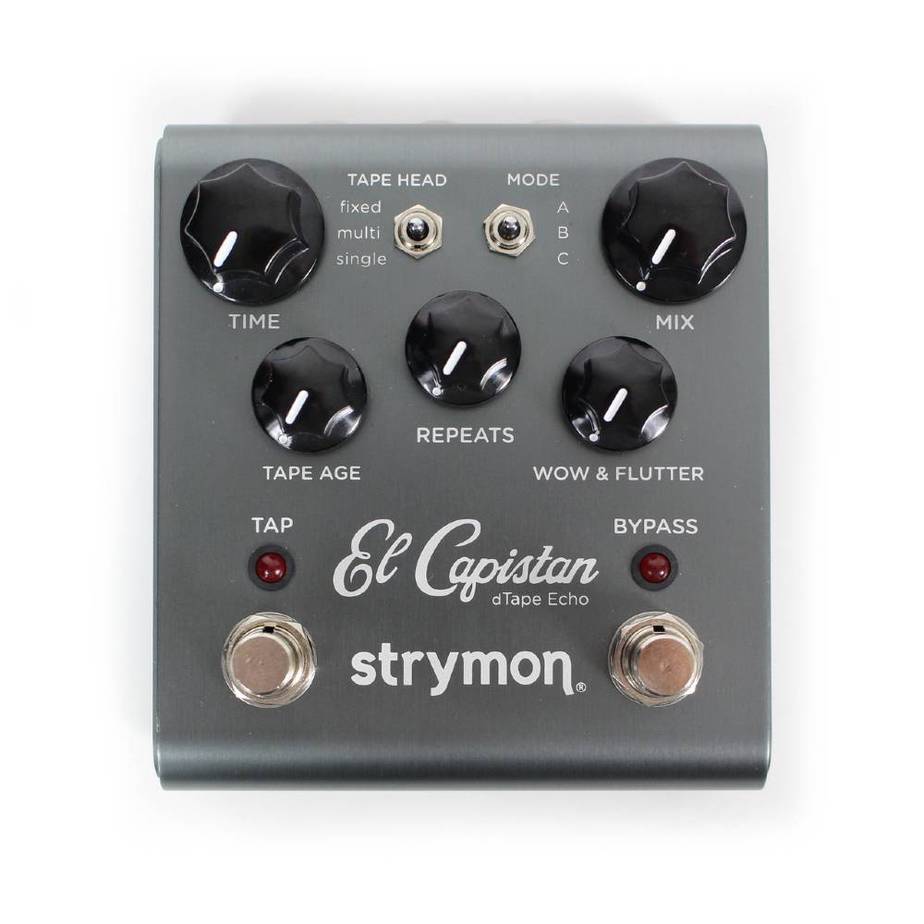
Strymon’s tape echo to rule all tape echos
El Capistan Specs
- Pedal Type: Stereo multi-mode Tape Echo unit
- Bypass: True Bypass
- Controls: Tape Head / Mode / Time / Tape Age / Repeats / Wow & Flutter / Mix / Tap
- Sockets: Stereo in/out, Expression pedal
- Power: 9V, 250mA
El Capistan Review
Despite the mouthful of a name, the dTape Echo Delay is one of the most popular delays out there. It retails for a chunky $300+ dollars, but the device more than justifies the price.
Winning multiple awards when it first came out, this unique delay pedal aims to recreate the sound of a vintage Tape Echo unit, but without the notorious issues related to maintaining the classic originals.
Despite being an analog delay pedal, the dTape Echo has a patented Sharc DSP Technology integrated into it, giving you complete control over every single aspect of the Tape Echo. This includes machine health, tone aging, delay time, tape age, and more all within that rich and warm analog sound.
The result is the ability to create a tape delay effect that can be of studio quality, or studio apartment quality.
While tape delays may be a niche sound to cater to, enthusiasts are going to find that you can’t get better than this.
DOD Rubberneck
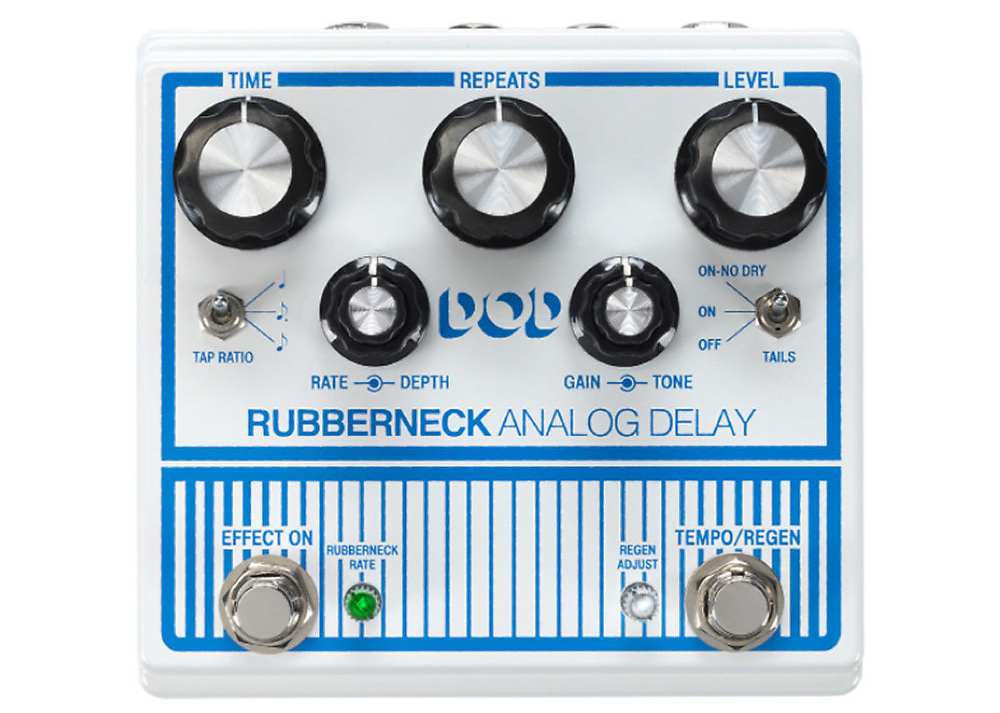
Analog delay with a number of advanced features
Rubberneck Specs
- Pedal Type: Analog Delay Unit
- Bypass: True Bypass
- Controls: Time / Repeats / Level / Rate&Depth / Gain&Tone / Rap Ratio / Trails
- Sockets: In/out, Send/Return, Footswitch
- Power: 9V, 150ma
Rubberneck Review
Given the unique nature of the sound, crowning a definitive best analog delay pedal is a difficult and near-impossible task. Despite this, our number one pick is the DOD Rubberneck.
For the $300 you’re going to be spending on this one, you get an analog that can do it all, from the usual delay sounds and melodies to the more unusual and peculiar sounds you’re going to be looking for.
The main selling point of this analog is the oscillation that you can get in your repeats. Not only do these oscillations sound sick, but you can vary them in intensity for maximum control.
You also have controls for tone and gain, offering you much more customizability than you typically see in analog pedals. Keeping in theme with that, the Rubberneck also has a much longer delay time than you might be used to with analog, as well as having tap tempo functionality.
All this makes the DOD Rubberneck an analog capable of a wide range of sounds from quirky to typical, marking it a standout in this market segment..
How to Choose the Right Delay
One of the things that makes buying a delay pedal both difficult and easy is that there is a huge variety of delay pedals available – but once you work out what kind of delay you want or need, it’s quite possible to hone in on one model that does exactly what you need (and honestly, it’s probably the Strymon Timeline because that thing does everything).
Major Considerations
However, before you go down the black hole, it is very important to nail down exactly what you need because it’s easy to get distracted by shiny sounds and end up with a pedal that’s ten times your budget and twice as big as your pedal board.
For that reason, before you do anything, you want to work out the following:
- What is my budget? Pick it and stick to it.
- Do I want a one-trick pony or a multi-mode unit? If all you want is to enhance your 80s licks, you want something simple. If you’re in Explosions In The Sky, you want something super serious.
- How much space do I have on my pedalboard? Do you want to have to upgrade your entire pedalboard to add one pedal? Don’t go buying a huge Strymon and then try to fit it into a Boss shaped space on your board.
- What will my power supply support? If you’re good adding another wall wart to your pedalboard, then you should be fine, but some of these multi-mode units use up a ton of power, and your board’s power supply might not run your new pedal.
The Three Main Types Of Delay
There are three main types of delay – tape echo, analog delay, and digital delay.
Let’s give a brief overview of each.
Tape Echo
People generally think of tape echo as having a vintage, somewhat warbly and decaying sound.
Tape Echo was pioneered by Les Paul himself (of Gibson fame). He used a tape machine to record a portion of his guitar signal and then play it back, allowing him to play along with it – typically two machines were used, one recording and one playing in real-time. Before anyone talked about “delays,” this was simply considered an echo, hence “Tape Echo”.
Modern “Tape Echo” delay pedals seek to emulate the idiosyncratic sound of the original tape-based delays. Tape was always quite inconsistent, and over time, tapes themselves would deteriorate, giving the delay or echo a very distinctive decayed sound. If you want your delay to have an old-school sound, tape delay is for you.
Analog Delay
People typically think of analog delay pedals as sounding musical, warm, and generally more pleasing than other types of delay.
They use something called a bucket-brigade device (BBD) which was developed by Boss – basically, they send the analog guitar signal through capacitors that repeat it once with each clock cycle.
While the chips limit the length of of the delay and the number of repeats, you will find that the repeats are warmer and darker than the original signal, which gives analog delay it’s distinctive sound.
Digital Delay
With digital delay pedals, the key is flexibility, as the signal can be processed in any number of ways, allowing the manufacturer to color the delay however they want.
As you would expect, a digital delay pedal uses a DSP chip programmed by pedal designers to offer whatever set of features they want their pedal to be known for.
For this reason, digital delay itself doesn’t have a “sound”, though many will tell you digital is sterile (or whatever elitist nonsense people are talking about now.
Summary
All you have to remember is that tape echo is going to sound vintage, analog delay will be warm, and digital delay can be whatever you want.
Additional Delay Pedal Features
There are many features unique to the delay pedals that you’ll want to keep in mind when picking the right one for you. Some are on most pedals, and some are on few – once you have a feature set in mind, it will be a lot easier to pick your ideal pedal.
Preset Recall
This can be vital for certain guitarists because, for many, a delay pedal isn’t “set it and forget it.” Depending on the effect you’re going for or even the tempo of the song, you’ll want to have a number of different delay settings throughout a gig.
For this reason, it’s important to know if the pedals you’re looking at allow you to save your presets – and just as important is how easy it is to access them.
Many higher-end multi-effect units will allow you to save hundreds of presets in banks that you can access by clicking different footswitches on the unit. This makes switching between songs a breeze.
However, if you’re that 80s hair metal dude, this is a case of “not my job, not my prob”.
Tap Tempo
This one is pretty simple – if you want the repeats from your delay to be in sync with the tempo of the song, you need tap-tempo.
This gives you either a button or a footswitch on the unit to tap in order to set the delay time, allowing you to directly control the tempo of your delay so that it syncs up with the rest of the band. “Tap Tempo” – right?
Without tap tempo, you’ll have to eyeball it – and that is a recipe for disaster.
Looping
A lot of people opt for a stand-alone looper, but if you’re trying to save space on your pedal board and you’re already eyeing a more expensive multi-mode unit, getting one with a looper built in can be a no-brainer.
By the way, if you don’t have a looper, get one. They’re a killer practice tool as you can record a riff and then solo over it to your heart’s content. Simple.
Range Of Delays
Tape echo pedals and analog pedals typically give you one type of delay, but when you get into the realm of the multi-mode delay pedal, you will find the pedals will do a wide range of different delays.
For this reason it’s important, if you are one of the guys from Explosions In The Sky, to have a clear idea of what types of delay you want in your unit, and then make sure the delays you’re looking at cover all those bases.
Final Thoughts
When you’re looking at delay pedals, there really is an abundance of choice on the market – and for that reason, it can feel like you’re being bombarded with options.
However, as long as you do your homework, choose between the three types of delay, and then think about the features you may want, such as tap tempo, preset banks, and different modes, you’ll quickly narrow down your options to a handful of pedals.
To recap our favorites, take a look at our Best Budget pick, the TC Electronic Flashback 2 if you’re looking for great performance without breaking the bank. If you’re looking for maximum features and the best range of tones possible, delay pedals don’t get better than our Editor’s Choice, the Strymon Timeline.
And then you buy a second delay to play the first one through. That’s when the real fun starts!


